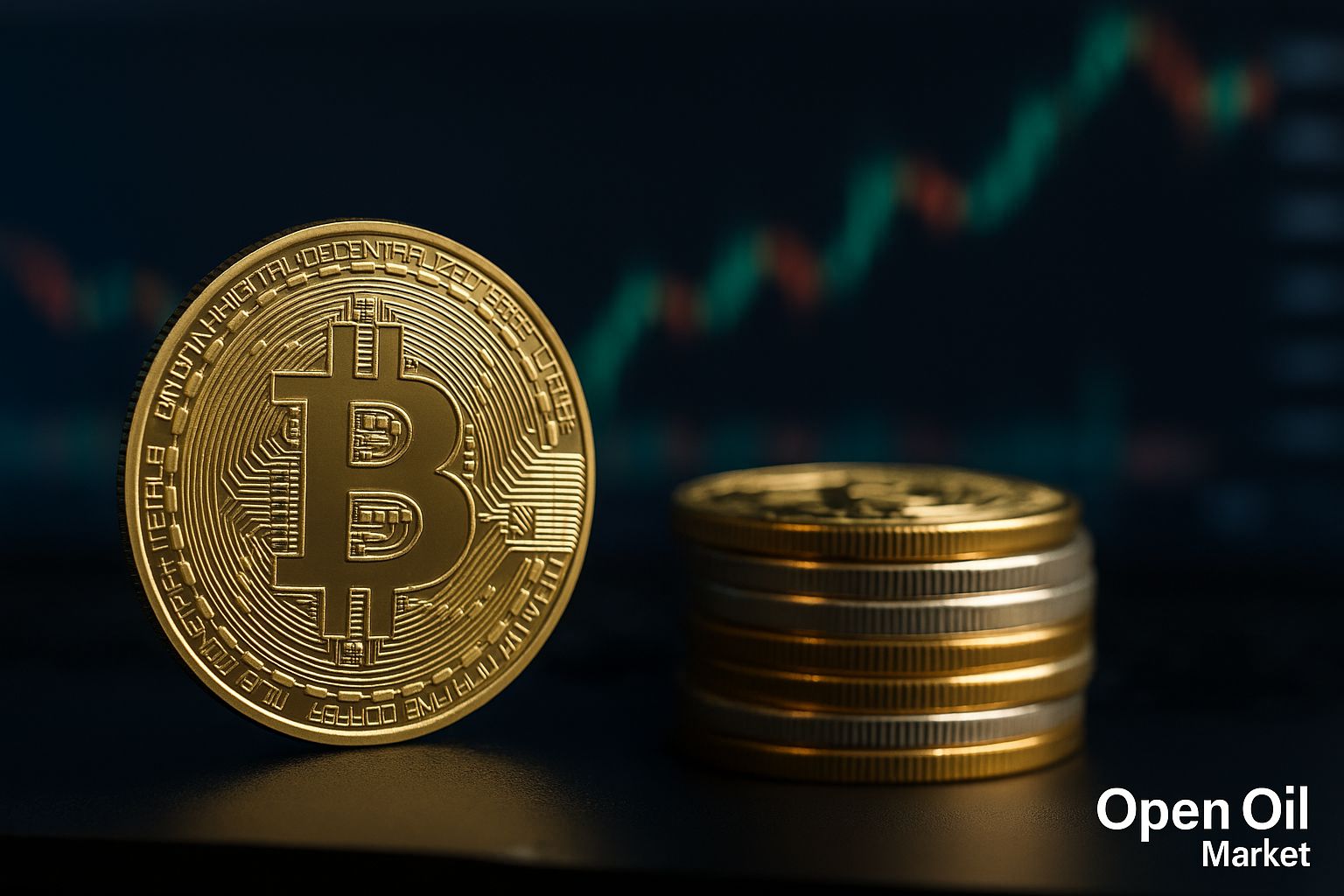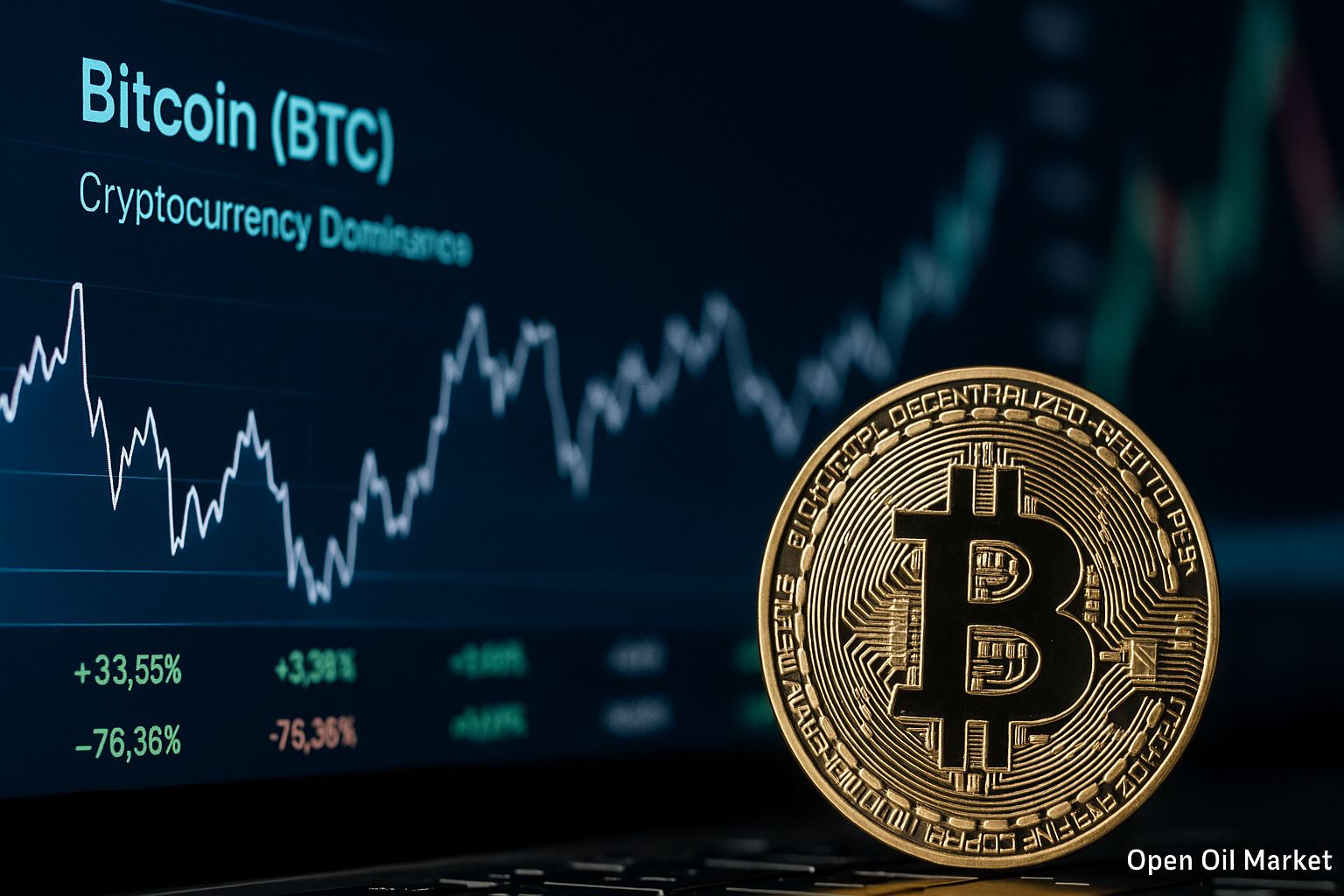
Current Cryptocurrency News as of November 12, 2025: Bitcoin Holds Above $100,000, Market Consolidation After Rally, Traditional Finance Enters Crypto Market with Initial Banks and ETFs, Investors Await Key Economic Data, Top 10 Popular Cryptocurrencies.
Bitcoin Maintains Its Position Amid Optimism
Following a rapid rise in previous months, Bitcoin (BTC) is holding its six-figure price levels. As of November 12, the leading cryptocurrency is trading at approximately $105,000, slightly down from record peaks in August (~$124,000), but still significantly higher than the levels at the beginning of the year. The market capitalization of BTC stands at around $2.1 trillion (about 58% of the total cryptocurrency market capitalization), confirming Bitcoin's dominant role. Experts note that the end of the prolonged U.S. government shutdown and the associated positive macroeconomic shifts have increased investor confidence. The U.S. Senate approved a budget agreement this week, ending a 41-day government shutdown and alleviating market uncertainty. Additionally, signals are emerging regarding a potential distribution of "tariff dividends" – President Donald Trump proposed to allocate revenue from import duties for one-time payments of $2,000 to citizens. These measures have heightened expectations that liquidity influx and economic stability will support demand for risk assets, including Bitcoin. Analysts suggest that BTC now has a clear path to new highs if it can confidently surpass the next significant milestone (around ~$110,000). Overall sentiment surrounding Bitcoin remains predominantly optimistic, with investors viewing it as "digital gold" and a hedge against inflation risks, particularly amid easing monetary policy.
Ethereum and Major Altcoins: Mixed Dynamics
The second-largest cryptocurrency by market cap, Ethereum (ETH), is trading steadily after the summer rally. The current price of ETH is around ~$3,550, slightly below its historical peak ($4,890 in 2021), but confirming Ethereum's strong positions. Ethereum continues to hold approximately ~12% of the market's total capitalization (around $420 billion), remaining the foundational platform for smart contracts, decentralized finance (DeFi), and numerous applications. Investor interest in ETH is supported by ecosystem development and institutional demand: recently launched spot ETFs for Ethereum in the U.S. have simplified access to this asset for institutional players. Although Ethereum funds, like Bitcoin, have experienced outflows in recent weeks due to profit-taking, long-term sentiment around ETH remains positive. Several leading market altcoins show mixed movement. Following a robust rally at the beginning of the month, some alternative coins have entered a consolidation phase as investors reassess risks and take profits. Nevertheless, specific projects exhibit resilience and growth due to their own news. For instance, the decentralized exchange Uniswap's (UNI) token saw a spike of more than 20% this week after the team proposed introducing a fee structure (making the token deflationary), although it has since retraced from its local peak. Overall, the broad altcoin market remains volatile, with many coins trading with fluctuations of 5-10% over the week, responding to news about technologies, partnerships, and regulatory developments.
Traditional Finance Embraces Cryptocurrencies
The crypto industry is receiving increasing support from traditional financial institutions. A landmark event occurred this week as the American bank SoFi announced the launch of cryptocurrency trading services for its clients. SoFi has become the first bank in the U.S. to offer direct purchases, sales, and storage of digital assets, including Bitcoin, Ethereum, and Solana. Company leadership noted that this decision was made possible by clarified regulatory guidelines – in spring 2025, the Office of the Comptroller of the Currency (OCC) officially allowed federally chartered banks to provide cryptocurrency services. Following these clarifications and increasing client demand, several major banks have begun exploring opportunities in digital assets. The launch of SoFi's crypto services marks an important step toward integration: retail investors can now access the crypto market through familiar banking apps, expanding the market audience. Moreover, SoFi announced plans to issue its own stablecoin (a digital dollar pegged to the USD) and integrate blockchain technologies into its lending and payment products. Experts believe that SoFi's example will spur other players in the banking sector to join the cryptocurrency space. Simultaneously, traditional investment funds continue to launch new products, with various countries seeing the emergence of crypto ETFs and trusts targeting a wide range of assets – from Bitcoin and Ethereum to baskets of altcoins. Such activity from financial companies indicates that cryptocurrencies are increasingly seen as a legitimate investment asset class.
Regulation: End of the Shutdown and New Legislative Initiatives
The regulatory environment surrounding cryptocurrencies continues to improve, removing barriers for the market. The conclusion of the budget crisis in the U.S. has not only positively impacted investor sentiment but also unlocked legislative activity. A new comprehensive bill regulating the cryptocurrency market is advancing in Congress. This week, the Senate Agriculture Committee introduced the "Crypto Market Structure Bill," which proposes to establish clear rules for the digital asset industry. Legislators intend to delineate the authority of regulatory bodies: under the initiative, supervisory functions will largely be transferred to the Commodity Futures Trading Commission (CFTC) for oversight of trading platforms and crypto asset derivatives, while the Securities and Exchange Commission (SEC) will concentrate on tokens that fall under the category of securities. The goal of the bill is to ensure market transparency and investor protection without stifling innovation. The U.S. administration also shows support for the development of the fintech sector: plans for the so-called "New Structure Bill," aimed at modernizing the financial system, have been announced, in which the cryptocurrency industry could play a significant role. Similar trends toward integrating cryptocurrencies into the legal framework can be observed in other countries. For instance, Brazil's central bank recently extended anti-money laundering (AML) and counter-terrorism financing requirements to cryptocurrency companies and service providers dealing with Bitcoin. The European Union previously approved comprehensive MiCA regulations, and their phased implementation in 2024-2025 is already stimulating opportunities for licensed crypto exchanges in Europe. Overall, regulators worldwide are increasingly engaged in developing rules for digital assets – this factor alleviates uncertainty and encourages more conservative investors to enter the sector.
Institutional Interest and Capital Movement
Large investors remain interested in cryptocurrencies, although mixed trends are observed in capital flows in the short term. After record inflows into crypto funds during the summer, a correction occurred in the fall: over the past two weeks, digital investment products have recorded a net outflow of about $1.1 billion, primarily from Bitcoin and Ethereum funds. Data from CoinShares indicate that approximately $900 million was withdrawn from Bitcoin funds last week, while Ethereum funds saw an outflow of around $400 million, as some investors opted to take profits after price increases. However, not all market segments are experiencing outflows. The XRP token, on the contrary, is attracting new capital: XRP-focused funds garnered about $28 million in inflows during the same week. This indicates a reallocation of interest – some investors are transferring capital into alternative digital assets with clear practical value. Overall, the total cryptocurrency market capitalization remains around $3.6 trillion, which is 5% above the November lows, signaling a gradual return of buyers. Institutional players continue to utilize market pullbacks to increase positions. For instance, analysts report that large holders (“whales”) recently bought about $200 million worth of Cardano (ADA) tokens on price dips, demonstrating confidence in the asset's long-term prospects despite delays in the launch of ETFs for it. There is also a continued inflow into already launched cryptocurrency exchange-traded funds. After a temporary pause at the beginning of the month, small net inflows were recorded into U.S. Bitcoin spot ETFs (around $1.2 million in the last 24 hours as of November 11), indicating a stabilization of sentiment. Interest is also spreading to other assets: recently, the first spot ETF for XRP ("Canary") was registered in the U.S., and the total assets under management for the XRP ETF have already exceeded $800 million in the initial trading days. Additionally, new exchange-traded funds focused on Solana have appeared in the U.S. market, also starting to attract capital, signaling an expansion of investment tools for cryptocurrency. The activity of such products, along with the participation of public companies (e.g., MicroStrategy, which continues to increase its BTC holdings), confirms that the institutional segment has firmly established itself in the crypto ecosystem.
Market Sentiment and Forecasts
The sentiment in the cryptocurrency market in mid-November can be characterized as cautiously optimistic. The "fear and greed" index for Bitcoin and major altcoins is in the moderate "greed" zone, indicating predominant optimism, albeit without extreme euphoria. Market participants are inspired by a combination of favorable factors – from easing monetary policy to positive news about regulation and the integration of cryptocurrencies into traditional finance. However, experts caution about the risks of short-term volatility. Rapid price increases in previous weeks have led to a series of liquidations in futures markets: on certain days, the total volume of forced liquidations reached several hundred million dollars. This indicates that some leveraged traders have faced losses from sharp price fluctuations. Analysts advise investors to exercise caution and adhere to risk management strategies, as technical pullbacks may occur after a strong rally. Nevertheless, medium-term forecasts remain largely positive. Many observers believe that the market has entered the "second phase" of a bullish cycle: following the peak updates in August and the subsequent correction, a consolidation phase is likely to ensue, followed by a new wave of growth as the next year approaches. A number of bold forecasts from major financial institutions remain valid. For instance, strategists at Standard Chartered have earlier raised their target for Bitcoin to $200,000 by the end of 2025, based on expectations of further institutional capital inflows. Other experts are more cautious but also predict growth: for example, several analysts anticipate Bitcoin advancing towards ~$130,000 in the coming months if economic conditions remain favorable. A key factor for short-term dynamics will be macroeconomic statistics. Fresh data on the Consumer Price Index (CPI) for October will be released in the U.S. tomorrow, November 13. This report is viewed by investors as critically important: moderate inflation could strengthen hopes for a rate cut from the Federal Reserve. According to CME FedWatch futures, the probability of the first rate cut at the Federal Reserve's meeting in December is estimated by the market at approximately 60-70%. Easing monetary policy typically boosts risk appetite and could trigger a new stage of the crypto rally. Overall, if current trends persist – with increasing institutional involvement, support from regulators, and improving macroeconomic conditions – most experts expect the cryptocurrency market capitalization to grow by year-end and the sector to strengthen further in 2026.
Top 10 Most Popular Cryptocurrencies
As of the morning of November 12, 2025, the top ten most popular cryptocurrencies by market capitalization include the following digital assets:
- Bitcoin (BTC) — the first and largest cryptocurrency. BTC is currently trading around $105,000 after a correction from August’s peak; Bitcoin’s market capitalization stands at approximately $2.1 trillion (≈58% of the overall market).
- Ethereum (ETH) — the leading altcoin and smart contract platform. The price of ETH is approximately $3,550, significantly above last year’s levels; its market cap is around $420 billion (≈12% of the market).
- Tether (USDT) — the largest stablecoin, pegged to the U.S. dollar at a 1:1 ratio. USDT is widely used for trading and settlements; its market capitalization is about $150 billion, and the price remains consistently around $1.00.
- Binance Coin (BNB) — the coin of the largest cryptocurrency exchange Binance and the native token of the BNB Chain. The price of BNB is around $950, close to its historical peak; market cap is approximately $140 billion. Despite legal pressures on Binance, the token remains among the leaders due to its active use on the platform and in DeFi.
- Ripple (XRP) — the token of the Ripple payment network for cross-border transactions. XRP is trading around $2.50; its market cap is estimated at approximately $130 billion. Legal clarity regarding XRP's status in the U.S. (Ripple's victory in its dispute with the SEC) has strengthened investor confidence and allowed the token to retain its place among leading assets.
- Solana (SOL) — a high-performance blockchain platform for decentralized applications. SOL holds around $160 per coin (market cap ~$80 billion), down from peaks of $200 reached earlier this year. Interest in Solana is supported by the growth of its ecosystem and the emergence of investment products (ETFs) focused on this asset.
- USD Coin (USDC) — the second-largest stablecoin, backed by dollar reserves (issued by Circle). The price of USDC is maintained strictly at $1.00; its market cap is around $60 billion. USDC is widely used by institutional investors and in DeFi due to its transparency and regular audits of reserves.
- Cardano (ADA) — a blockchain platform emphasizing a scientific approach to development. ADA is currently priced at about $0.70 (market cap ~$25 billion) following a retreat from recent local highs around $1.00. Cardano attracts attention due to plans for launching an ETF for this token and its active community, which believes in the long-term growth of the project.
- TRON (TRX) — a platform for smart contracts and decentralized applications, particularly popular in Asia. TRX is trading around $0.30; market worth is ~ $28 billion. TRON maintains its place in the top 10 largely due to its network being used for issuing stablecoins (a significant portion of USDT circulates on the Tron blockchain) and ongoing ecosystem development.
- Dogecoin (DOGE) — the most famous meme cryptocurrency, originally created as a joke. DOGE holds near $0.18 (market cap ~$30 billion), supported by community loyalty and periodic attention from celebrities. Despite its high volatility, Dogecoin continues to rank among the top ten largest coins, demonstrating remarkable resilience in investor interest.




